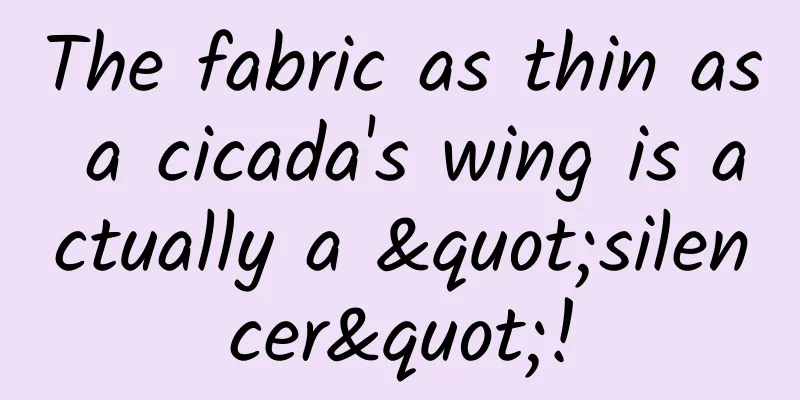The fabric as thin as a cicada's wing is actually a "silencer"!

|
Produced by: Science Popularization China Author: Guo Fei (Yantai University) Producer: China Science Expo Editor's note: In order to understand the latest developments in cutting-edge science and technology, the China Science Popularization Frontier Science Project has launched a series of articles titled "Understanding Top Science Journals", which selects outstanding papers from authoritative journals and interprets them in plain language as soon as possible. Let us broaden our scientific horizons and enjoy the fun of science through the window of top journals. Noise is the ubiquitous "public enemy" in modern society. The roar of machines, the clamor of cars, the noise of people... the constant noise not only affects our mood, but also damages our health. To fight against noise, we need the help of sound insulation materials. The latest research shows that a silk fabric as thin as the wings of a summer cicada may become a "magic weapon" to eliminate noise. This groundbreaking research comes from an interdisciplinary team from MIT and other institutions. Inspired by noise-canceling headphones, they designed a special silk fabric. At first glance, it looks just like ordinary silk, thin and light, and feels silky. But woven into it are piezoelectric fibers with "superpowers". Schematic diagram of anti-noise fabric (a. Transmission; b. Transmission; c. Active noise reduction; d. Vibration noise suppression) (Image source: Reference 1) What is piezoelectricity? The piezoelectric effect, derived from the Greek word "piezein", means "to compress" or "to squeeze". This effect refers to the fact that when certain materials are subjected to mechanical stress, electric charges are generated on the surface, thereby forming a voltage. This phenomenon was first discovered in 1880 by the Curie brothers (Jacques and Pierre Curie) while studying quartz crystals. Piezoelectric materials can be divided into naturally occurring crystals (such as quartz, salt crystals, certain biological materials such as bone and DNA) and artificially synthesized materials (such as certain ceramics and polymers). The common feature of these materials is that their crystal structure is non-centrosymmetric, which makes their lattice easily shift under the action of external force, thereby accumulating charges on their surface. When a strain gauge made of piezoelectric material changes shape, it generates voltage (this is an exaggerated diagram) (Image source: Wikipedia) Gif From lighters and piezoelectric ignition stoves in daily life to medical imaging equipment and precision industrial sensors in the high-tech field, piezoelectric technology has a wide range of applications in modern technology. For example, in the medical field, piezoelectric materials are used to manufacture ultrasonic imaging devices, which can observe the internal structure of the human body non-invasively and are an indispensable part of modern diagnostic technology. In industrial applications, piezoelectric sensors can detect the operating status and health of machines, helping with maintenance and fault diagnosis. The common piezoelectric effect is divided into the following two modes. The first mode is the direct piezoelectric effect. When a piezoelectric material is subjected to an external force (such as pressure or tension), the deformation of its internal crystal structure causes a redistribution of charge, which in turn generates a voltage across the material. This effect is often used to make sensors and power generation devices. For example, it is used to detect pressure changes or convert mechanical energy into electrical energy. The second mode is the inverse piezoelectric effect. In contrast to the direct piezoelectric effect, when voltage is applied to a piezoelectric material, the material undergoes physical deformation. This effect is widely used in precision control systems such as precision drivers and acoustic vibrators. The inverse piezoelectric effect allows materials to produce precise mechanical movements under the control of electrical signals. The piezoelectric fibers used in the sound-insulating silk made in the study mentioned above rely on the inverse piezoelectric effect. When sound waves in the environment excite piezoelectric fibers, these fibers are able to convert the sound wave energy into electrical signals, and then generate relative mechanical vibrations through the inverse piezoelectric effect, emitting reverse sound waves to offset the original noise, thereby achieving efficient noise control. The “killer weapon” of magic silk The piezoelectric fibers in the sound-isolating silk must first "hear" the sound before they can suppress it. These magical fibers are like super-sensitive "ears". When there is noise nearby, they vibrate with the sound waves and convert the vibrations into electrical signals. The researchers cleverly used this feature to turn the fabric into an "invisible" microphone that captures the surrounding sounds in real time. But just hearing the sound is not enough, the key is to eliminate the noise. So scientists once again used their creativity to give silk the ability to "sound". That's right, this fabric can not only listen, but also "speak"! By controlling the vibration of the piezoelectric fibers, the fabric emits sound waves of a specific frequency to "compete" with the unwanted noise and cancel it out. Just like two people shouting at the same time, the sounds interfere with each other and they can't hear each other clearly, the noise is also "extinguished" by the reverse sound waves emitted by the fabric. An imaginary diagram of the working principle of active noise reduction technology. The blue waveform above represents normal music, the blue waveform below is background noise, and the red part is the sound waves actively emitted by the headphones to cancel out the noise. (Image source: AI synthesis) In addition to actively making sounds, this magical silk has another "killer feature". You know, the generation and propagation of sound are essentially derived from vibrations. If we can suppress these vibrations, we can prevent the generation of noise from the source, and this is the second mode of silk sound insulation. By adjusting the voltage, the piezoelectric fiber can be kept still, thus blocking the transmission of sound waves. This mode can be called a "silencing weapon" that can instantly quiet down noisy environments such as airplanes and cars. Experimental data confirms the sound insulation strength of silk fabric. In active cancellation mode, it can significantly reduce noise by up to 65 decibels, which is equivalent to turning a noisy restaurant into a library. In vibration suppression mode, it can reduce sound transmission by 75%. Compared with traditional sound insulation materials that look thick and clumsy, this layer of silk as thin as a cicada's wing is simply a "gentleman killer". Noise reduction silk (scale 1mm) (Image source: Reference 1) A strange combination of circumstances brings us to future technology It is worth mentioning that the original inspiration for this revolutionary sound insulation technology actually came from the research and development project of smart clothing. The researchers first tried to weave piezoelectric fibers into clothing for real-time detection of human vital signs, but they found that this material can also "hear" noise, which gave them an idea and a new noise reduction solution came into being. This kind of analogy demonstrates the charm of scientific research. Seemingly insignificant and unrelated discoveries often contain the power to change the world. The advent of noise-reducing silk has provided a new weapon for noise prevention and control, but scientists have not stopped there. They plan to further explore the potential of this material, study how to block multi-frequency noise, and continuously optimize the performance of the fabric by adjusting the weaving method of piezoelectric fibers, applied voltage and other parameters. It can be foreseen that after more technological iterations, this sound-insulating silk is expected to become a noise-reducing "panacea" that is light, breathable, efficient, and customizable, creating a quiet and comfortable living and working environment for people. Conclusion The significance of this research lies not only in the creation of a new type of soundproofing material, but also in the infinite imagination it contains. Imagine that in the future, our clothes, curtains, and wallpapers may all use this "soundproof silk" to create a peaceful world anytime and anywhere. In this noisy world, a small piece of silk may bring unexpected changes. Let us wait and see, and look forward to this black technology entering the homes of ordinary people as soon as possible, bringing long-lost tranquility to more people. References 1. Single Layer Silk and Cotton Woven Fabrics for Acoustic Emission and Active Sound Suppression, Grace H. Yang, Jinuan Lin, Henry Cheung, Guanchun Rui, Yongyi Zhao, Latika Balachander, Taigyu Joo, Hyunhee Lee, Zachary P. Smith, Lei Zhu, Chu Ma, Yoel Fink 2. Guyuan: Active noise reduction fabric is available, allowing you to wear "noise reduction headphones" in your room |
<<: Today, unlock another beauty of Xinjiang
>>: World Environment Day | Let’s protect our future together!
Recommend
91 Ten Articles - New Energy Vehicle Industry Briefing: Tesla and Hainan Accident Owner Reach Quick Settlement
1. Tesla and the owner of the Model 3 brake accid...
The average human life expectancy will be at least 108 years in 2030! How can we make the most of our increasingly long second half of life?
Living longer and healthier seems to be the commo...
Mobile App can monitor phone calls without authorization, with a success rate of up to 90%: the culprit is beyond your imagination
[[316407]] You'll never imagine how unreliabl...
Do you know the hidden ways to play the commonly used mobile phone apps?
Source: A student bully (bajie203) This article h...
Community Operation "Explosive" Transaction Logic
"How to achieve explosive sales in social me...
APP promotion: building user levels from 0 to 1
A useful or interesting APP user rating system ca...
How harmful is it to your body to always drink energy drinks? After reading the ingredient list, do you still dare to drink them?
Do you have friends around you who love to drink ...
"Newbie Wealth Training Camp" From a monthly income of 3K to assets of 10 million, 100% financial management system
I saw an interesting topic some time ago: one per...
The most popular iOS automation testing tools in 2022
The year-over-year growth in iOS device sales has...
Don't use a spoon when eating watermelon! This is a bad thing, I learned it after eating watermelon for many years
This article was reviewed by Liu Shaowei, food sa...
China Petroleum Memorial Day | Why is oil so precious? Will it be replaceable in the future?
74 years ago today, the Yumen Oilfield was libera...
It is said online that "the Forbidden City has lasted for 600 years and has never been flooded." Did the ancients really have advanced drainage technology?
Over the years, there has been a saying circulati...
Qiuye Office three-in-one office application, from novice to expert course
Qiuye Office 3-in-1 Tutorial: Word, Excel, PowerP...
If JAC Volkswagen’s first SUV is an iEV7S with a different shell, would you still buy it?
Ever since the establishment of the JAC Volkswage...
Zhongshan Mini Program Agency, how much does it cost to be an agent for an appointment registration mini program?
Zhongshan appointment registration mini program a...







![Zbrush course advanced animation full process case teaching model mapping chapter [HD quality with material]](/upload/images/67cc0621665ad.webp)

